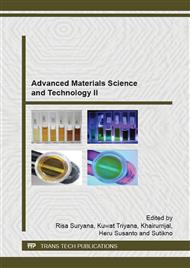p.104
p.109
p.114
p.119
p.123
p.127
p.131
p.135
p.140
Crystalline Characterization and Dielectric Constant of Barium Strontium Titanates Prepared by Solid State Reaction
Abstract:
Barium strontium titanate (BST) materials with the chemical formula of BaxSr1-xTiO3 had successfully made by solid state reaction method. The materials were made in the form of bulk. Ba mole composition was varied in the value of x = 0,5; 0,7; and 0,9. It was varied to study the influence on crystal structure and dielectric constant. The result of crystalline characterization performed by X-ray diffractometer instrument shows that changes in the composition of x causes a shift in the diffraction angle. The lattice parameter was obtained from the refinement with the GSAS software and calculation process. Lattice parameter of BST with a value of x = 0,5 and 0,7 are a = b = c, so that the crystal structure is cubic. While the BST with a value of x = 0,9 has lattice parameter a = b ≠ c, so that the crystal structure is tetragonal. Dielectric constant measurements performed at frequency of 1 KHz by RLC-meter instrument. The highest dielectric constant was obtained at 465 on Ba0,9Sr0,1TiO3. The dielectric constant of cubic-crystal structured material is bigger than tetragonal-crystal structured material.
Info:
Periodical:
Pages:
123-126
Citation:
Online since:
August 2015
Authors:
Keywords:
Price:
Сopyright:
© 2015 Trans Tech Publications Ltd. All Rights Reserved
Share:
Citation:


